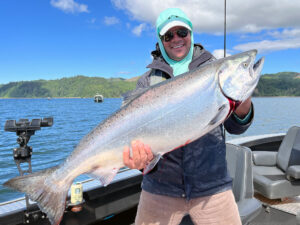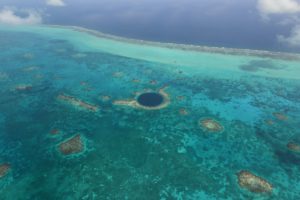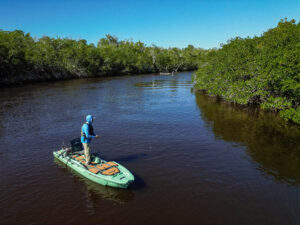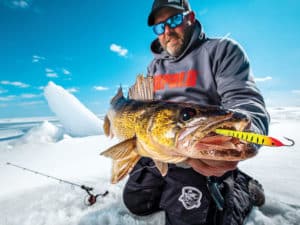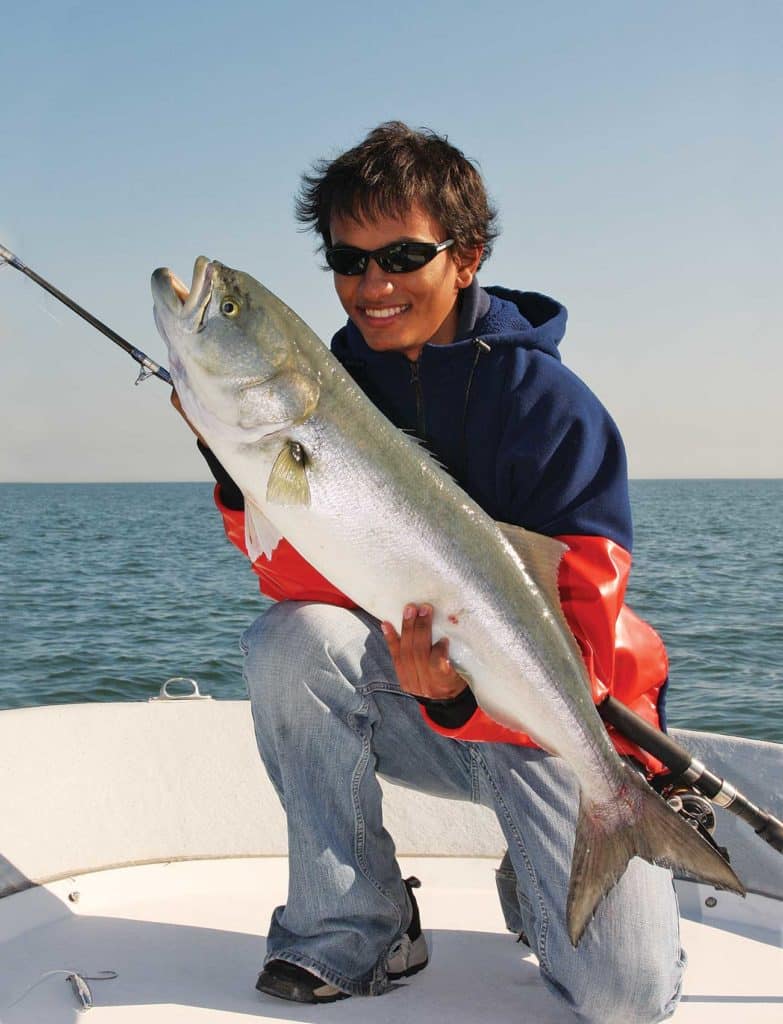
Newport Canyon begins its abyssal plummet a few hundred yards off California’s Newport Beach. I had cruised over it hundreds of times en route to distant Pacific waters. The trophies swim way out there, I thought.
Then, one day in late spring, my friend Dave Elm revealed that he had found a consistent bite on big thresher sharks, longtails up to 250 pounds.
“Where?” I asked.
“Close,” he answered, hesitant to elaborate on his bonanza. Eventually, however, he broke his silence. “We’re getting them around Newport Canyon.”
I had no idea.
This is just one example of an angler living in a major metropolitan area who has found that he need not always travel far to find trophy fish. We’ve discovered four other metro areas where — despite dense populations and heavy fishing pressure — you can catch trophy fish close to home.
Charleston Harbor, South Carolina: Bull Redfish
Capt. J.R. Waits
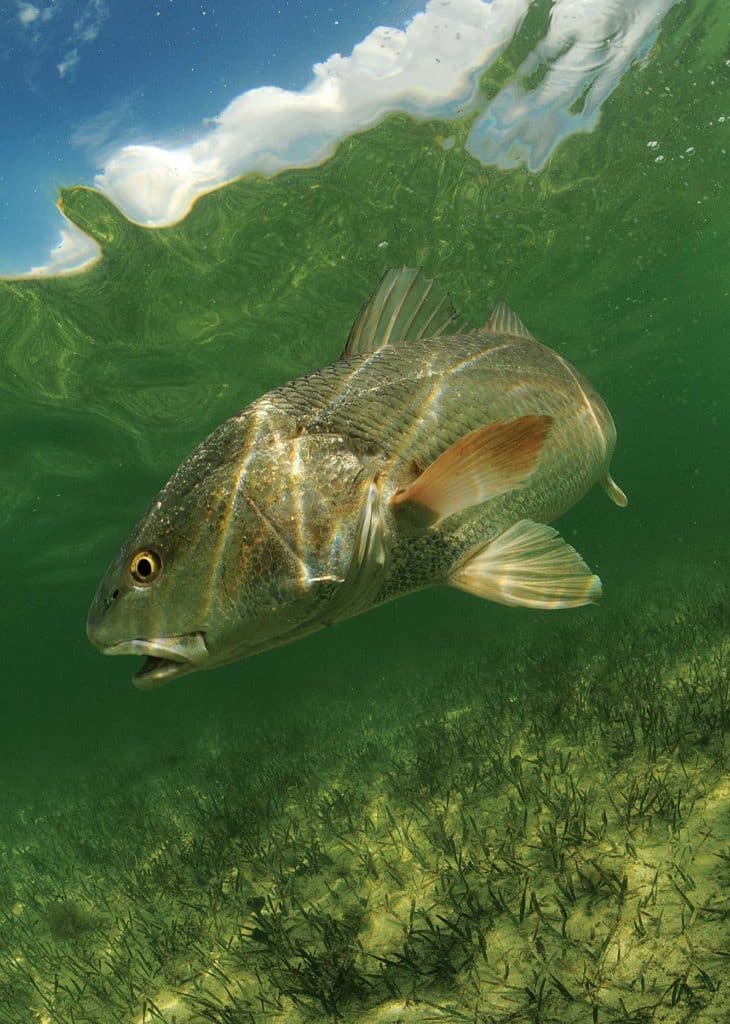
Fed by four tributaries and flushed by Atlantic tides, historic Charleston Harbor forms a near-ideal habitat for bull redfish. Few fisheries are closer to the center of a city; Charleston sits on a peninsula that juts into the northwest portion of the harbor.
Capt. J.R. Waits has specialized in putting his clients on trophy redfish for the past 20 years. “Every year we get fish over 30 pounds,” Waits says. “Every other year we get fish over 40.” On occasion his clients land still larger monsters: The biggest so far is 53 pounds.
“The redfish start showing up in the harbor in April to mid-June,” says Waits. “They come in from offshore, and the fishing keeps getting better through summer and fall.” The best month is October, he says.
While anglers like to refer to big redfish as “bulls,” Waits says the biggest redfish here are females: “The males average 12 to 15 pounds. Anything larger is usually a female.”
Waits focuses his efforts on steep drop-offs such as those formed by shipping channels and jetty edges. “You are looking for areas that drop down to 15 or 30 feet deep,” he says.
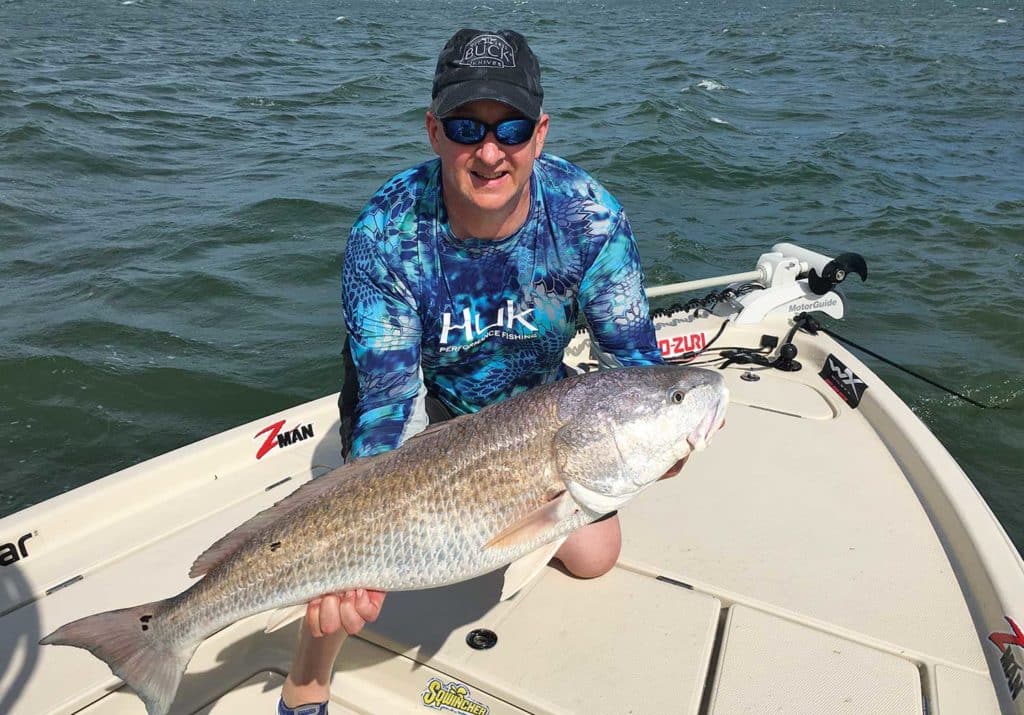
Typical areas include channels within the harbor, along the Charleston Jetty and an area known as the Grillage between the harbor and the jetty.
“The Grillage used to serve as a dumping ground for old ship parts,” Waits says. “It is about 70 feet deep, and the redfish seem to love it.”
A moderate current is key to triggering a bite in these areas. Waits likes to anchor up and fish live or cut bait along the bottom.
The captain uses a three-way rig and a 3- to 6-ounce bank sinker (the amount depends on the strength of the current) on a 4-inch loop of 25-pound-test monofilament. The main leader consists of a 10- to 18-inch length of the 60- to 80-pound-test fluorocarbon, tied to a Mustad 7/0 to 9/0 circle hook.
A 6½-foot jigging rod rated for 30- to 80-pound-test line with a medium-size spinning reel works best. Waits spools up with 50-pound-test braided line and uses a 6-foot-long top shot of 60-pound-test monofilament.
The go-to bait is a live menhaden, but the captain also fishes with live croakers and blue crabs. Sometimes the big redfish want chunk baits such as a menhaden body with the head and tail cut off.
When a bull redfish bites, you have to steer it away from the rocks and other structure, the captain points out. “I use a very heavy drag, but the big ones still scream line off the reel,” he says. “The fish also use the current to their advantage.”
Thus when it comes to finding, hooking and landing big redfish, Charleston Harbor is not necessarily a slam-dunk. But if it were easy, no one would categorize these large fish as trophies.
Long Island, New York: Cow Stripers
Capt. John Raguso
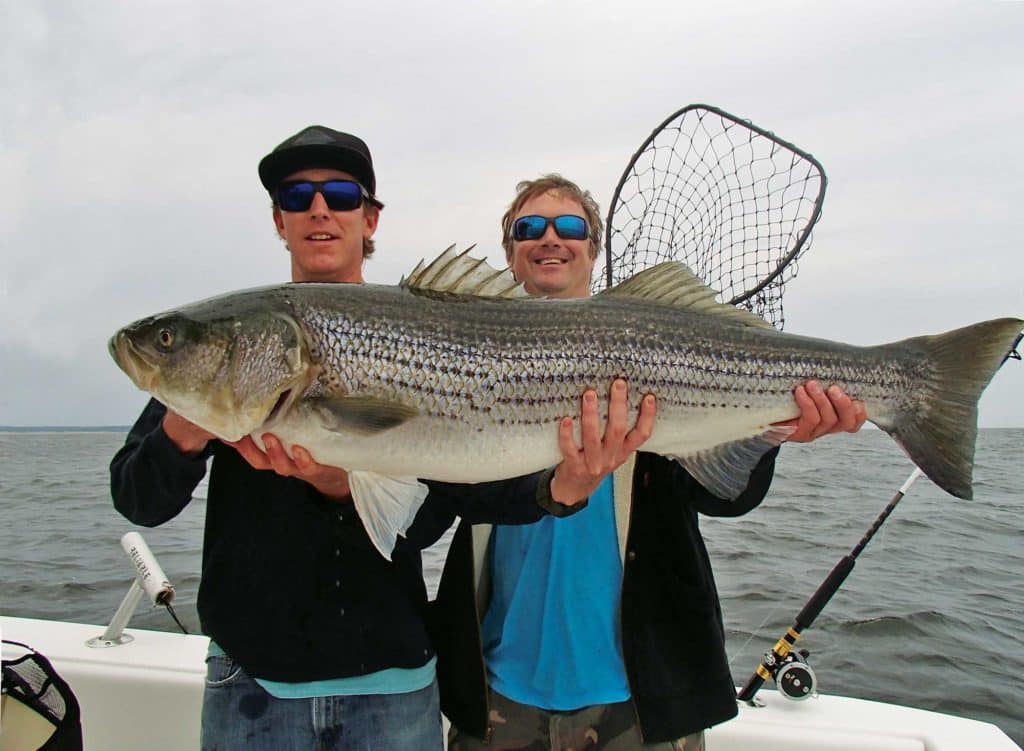
The western portion of New York’s Long Island is one of the most densely packed metro areas in the U.S., home to urban landmarks such as Brooklyn and Queens. Yet the island’s inshore waters are also some of the most productive fishing areas for striped bass.
Capt. John Raguso has fished here since the 1970s and believes that the opportunity to catch trophy striped bass — super cows in the 50- to 60-plus-pound range — is better than ever.
“The amount of menhaden in these waters is off the charts,” Raguso says. Striped bass are gorging on this forage and getting fatter all the time, he observes. Raguso has landed a quartet of stripers in excess of 40 pounds over the years, including his largest, a 46-pounder.
Finding the daily whereabouts of migratory schools of striped bass can be a challenge. Guides and sharpies use secretive networks to share local knowledge about the ever-moving bass, so chartering a trip with a professional guide who is tuned in to the daily movements is well worth the investment. For boating anglers striking out on their own, however, Raguso offers tips for when, where and how to catch a trophy striped bass.
“There’s really an eight-month season when you can catch striped bass off Long Island, April to mid-December,” he says. He adds that two distinct striper habitats exist.
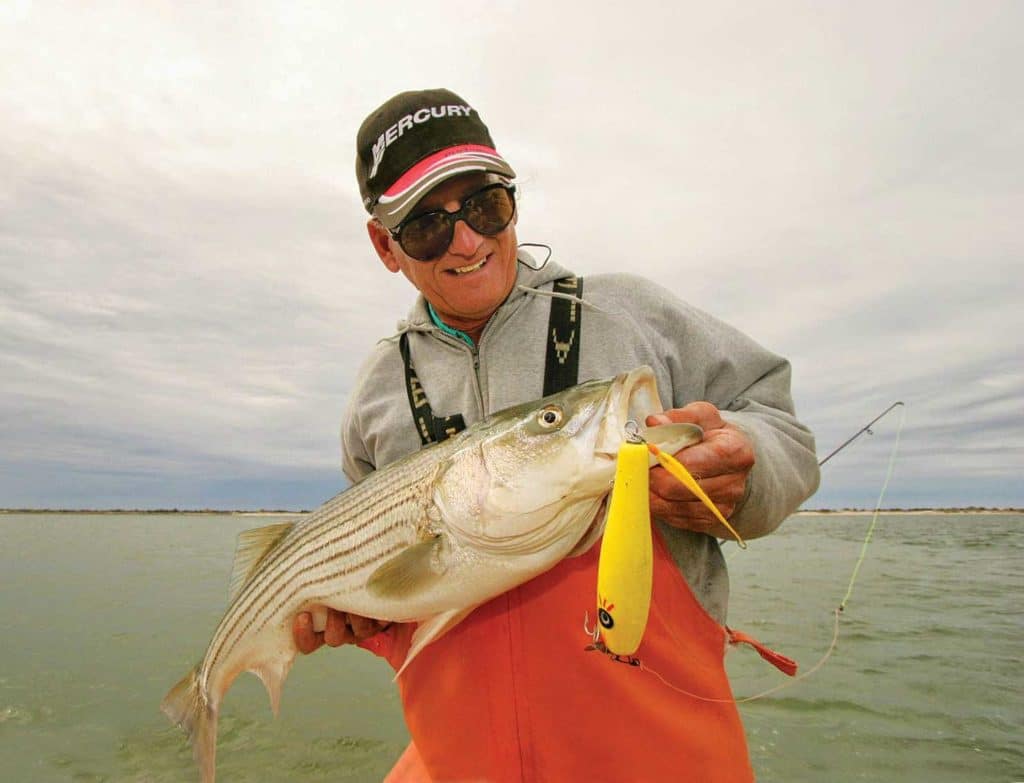
The first includes a number of bays and harbors that punctuate the north shore facing Long Island Sound; you are likely to find stripers in any of these. “Bays such as Little Neck, Manhasset, Hempstead, Oyster and Huntington can all hold dense quantities of stripers,” Raguso says.
The second prime habitat is along the south shore, Raguso reveals, where the inlets to the Atlantic Ocean are gold mines for striped bass anglers. When the tide is running, it brings with it a vast amount of food. A number of the inlets are easily accessible and only a short run from south shore ports and launch ramps. These inlets include Rockaway, East Rockaway, Jones, Fire Island, Moriches and Shinnecock.
When anglers are prospecting for striped bass, a big key lies in finding schools of menhaden (bunker). Dipping and diving birds are a dead giveaway.
While you can catch striped bass with a variety of techniques, such as trolling bunker spoons, umbrella rigs or parachute jigs with wire line; working poppers over rips; clam chumming; or squidding with diamond jigs, fishing with live bait such as menhaden is the best method for trophy fish. “Use a weighted snag rig to catch a menhaden, and then just leave it down there and let him swim around,” Raguso advises. “A big cow is likely to eat it.”
Raguso likes to use large levelwind reels spooled with 40-pound-test braided line and a 10- to 15-foot top shot of 40-pound-test fluorocarbon for the big stripers. He also likes to fish off hours, such as in the afternoon during the middle of the week, early in the morning, or at dusk. With less boat traffic and fishing pressure, those big, wary fish are more likely to bite. “But be advised, big stripers can bend your rods at any time when they are hungry and the water is flowing over their preferred structure,” Raguso says.
Miami-Dade County, Florida: King-Size Tarpon
Capt. Bouncer Smith
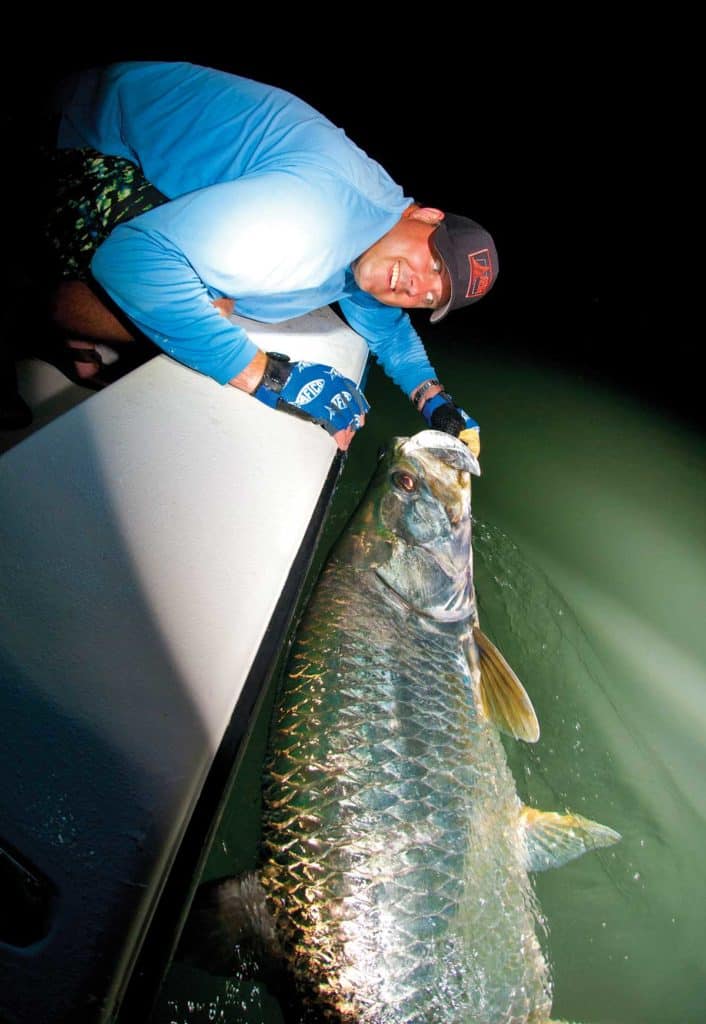
The Miami-Dade County metro area sprawls across southeast Florida from Homestead to North Miami Beach. Millions call this area home. It’s also a tourist mecca, with visitors flocking to the beaches and clubs. For anglers, however, big tarpon close to the big city are the real attraction.
Capt. Bouncer Smith rarely travels more than a mile or two from the dock to target silver kings. “The fishing starts as early as October,” Smith says. “It lasts through June, with some of the hottest action taking place in mid-February.”
Smith has released boat-side a number of fish in the high 100s, and two that exceeded 200 pounds, including an estimated 230-pounder. Finding tarpon consists of scanning the surface for rolling fish. “Tarpon have to gulp air in order to breathe properly,” Smith points out. “So you will see schools rolling during the day.”
At night, you can’t always see the fish, but you can hear them, the captain says. Tarpon make a popping noise, so Smith shuts down the motor, turns off the radio, asks everyone to stop talking, and then simply listens. “Once you locate the sound, approach from the upwind side and let the breeze carry you to the fish,” he advises.
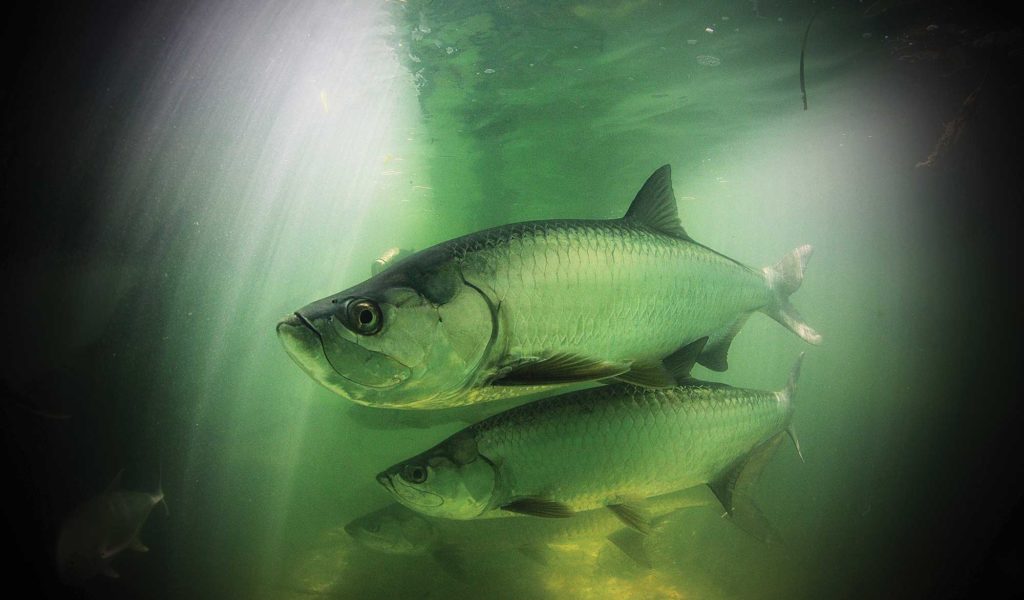
The captain fishes a variety of close-in spots, including Haulover Inlet, Dumbfounding Bay and the abutments of the Rickenbacker Causeway. One of his go-to spots is the iconic Government Cut and adjacent beaches. Moving water is critical; an outgoing tide that flushes out crabs, shrimp and baitfish is best.
One of Smith’s favorite techniques for big tarpon is to drift the inlets with live bait, paying out about 60 to 100 feet of line behind the boat. In the early season, the outside of the north jetty tends to produce best, while the main channel seems to kick out more tarpon in the middle of the season. Near the end of the season, the fish move back outside the north jetty.
The live bait of choice is also seasonal. Mullet produce well in the early season, but Smith switches to live shrimp from late November to April. Blue crabs work best late in the season.
Smith ties on VMC light-wire circle hooks for tarpon, using a 7/0 when fishing with live shrimp, an 8/0 for blue crabs, and a 9/0 for mullet. He bridles each mullet with a rubber band through the nostrils.
A spinning reel such as a Penn 6500 or 7500 loaded with 20-pound-test monofilament and a 50- to 60-pound-test leader works well for this style of fishing. Smith matches the reel to a 7-foot spinning rod rated for 20- to 40-pound-test line.
Once you hook up, stay close to the fish but not right over it, he advises. “The key is stopping its forward motion,” he says. “For that, you need to back away and apply side pressure. That’s the way to beat a trophy tarpon.”
Newport Beach, California: Thresher Sharks
Dave Elm, Production Manager, AFTCO
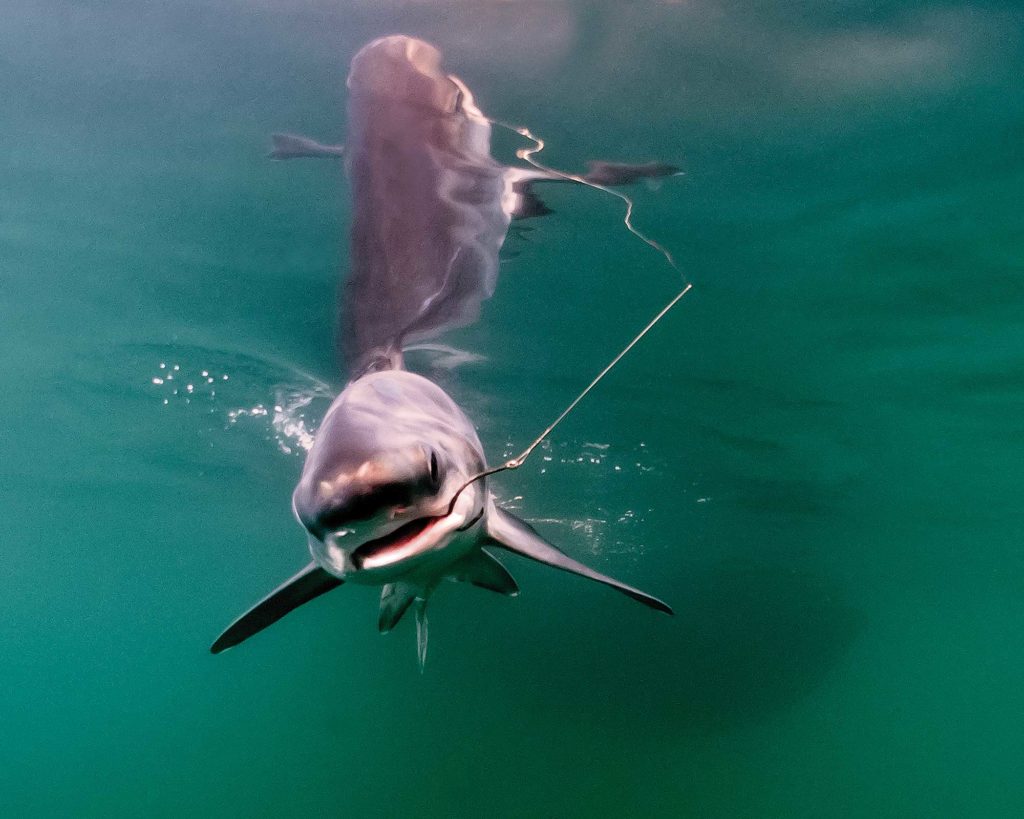
California’s Orange County region merges into one megalopolis, the greater Los Angeles area, with a mind-boggling population that snarls traffic, crowds beaches, and packs amusement parks. To many, this is the culture of Hollywood and surfing. Yet SoCal’s nearshore waters offer more than just surf. They also host migrating populations of thresher sharks.
Veteran saltwater angler, immediate past president of the Balboa Angling Club and production manager for AFTCO, Dave Elm has fished for thresher sharks here for more than 25 years, boating fish in the 100- to 200-pound class less than a mile off the beach.
“They can arrive as early as April and might stay through June,” Elm says. “Sometimes they come back through in September, October and November.” Surface water temperatures in the 64-degree F range are a key indicator, he says.
Elm likes to target the Newport Canyon area and the adjacent 50-fathom curve that drops off less than a mile outside the entrance to Newport Bay, as well as shallower water closer to the beach. Threshers sometimes feed just outside the surf zone.
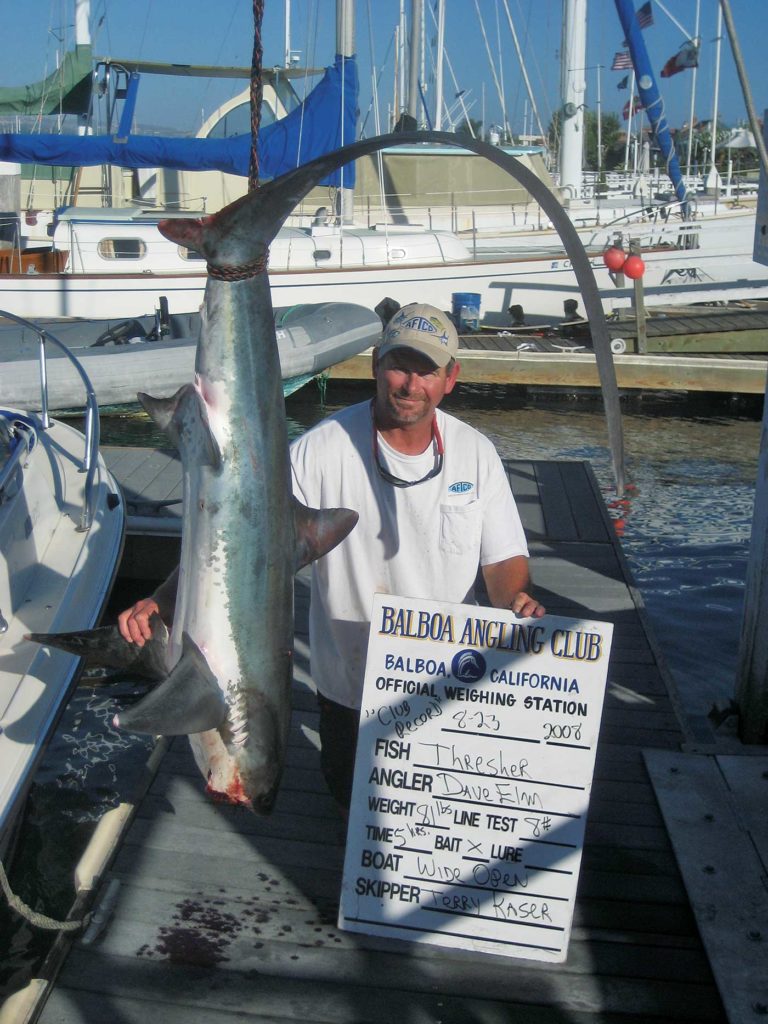
These sharks follow the biomass of anchovy schools, fattening up along the way. Fish in the 300- and 400-pound range have been caught around the canyons, which create an upwelling of nutrients and plankton that attracts and holds schools of baitfish.
“If you want to find threshers, you need to find the grocery store,” advises Elm in reference to forage fish. He likes to troll while scanning for birds such as gulls and terns dipping and diving on bait schools, while also keeping an eye on the fish finder for bait.
One issue with threshers: They slash at hooked baits with their long tails and can become foul-hooked, leading to prolonged, less-than-spectacular battles and a dead shark.
To avoid this, Elm trolls a hookless Bait-O-Matic lure with a whole dead mackerel pinned inside using a modified snap swivel. He trolls at about 3 knots with 100 to 150 feet of line out. Once a thresher attacks the lure or bait rig, Elm pulls the boat out of gear and reels the Bait-O-Matic to the boat.
“The thresher usually follows that teaser all the way to the transom,” he says. “Then we pull the lure out of the water and put a hooked bait in front of the fish. The thresher almost always inhales it.”
Getting a chance to eyeball the fish also gives Elm an opportunity to see if it is a trophy fish that he wants to catch. To prevent bite-offs, Elm uses a 2-foot section of 100-pound-test single-strand wire. Ahead of that is a 10-foot-long leader of 200-pound-test mono spliced to 50- or 60-pound-test braided line. When pursuing a line-class record, he spools up Ande IGFA-class monofilament of the appropriate test.
Elm likes to use fairly light tackle, such as a Shimano Trinidad 12 with a 7-foot rod rated for 20-pound-test line and AFTCO lightweight roller guides.
Raritan Bay, New Jersey: Gorilla Bluefish
Nick Honachefsky, Fishing Writer & TV Host
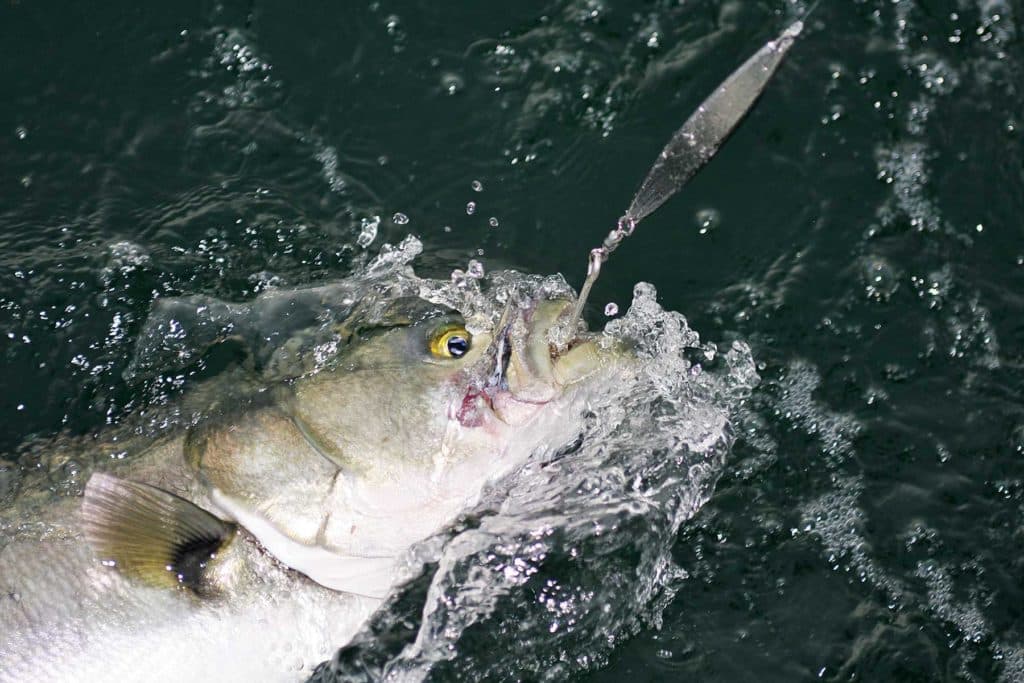
To paraphrase a famous line from the late comedian Rodney Dangerfield, northeastern New Jersey don’t get no respect. This densely populated area stretches from the top of the state to the Raritan River, playing second fiddle to the glitz of Manhattan across the Hudson River. Yet just south, in Raritan Bay (bisected by a common border with New York), Jerseyans have quick access to one of the best fisheries for bluefish along the Eastern Seaboard.
Fishing writer and TV host Nick Honachefsky has fished the New Jersey coast for decades, and believes now is the best time to catch huge bluefish, including so-called gators in the 12- to 18-pound class and coveted gorillas over 20 pounds.
“The fish move into Raritan Bay in the spring and gorge themselves on bunker,” says Honachefsky. “By summer and early fall, these fish can reach 20 pounds or more.” While bluefish might not get the respect that anglers have for striped bass, blues of these proportions are real trophies.
A productive way to target bluefish is to chase breaking fish when they’re smashing bunker schools, says Honachefsky. Casting poppers such as a Yo-Zuri Bull Pop or Halco Roosta Popper adds to the rush.
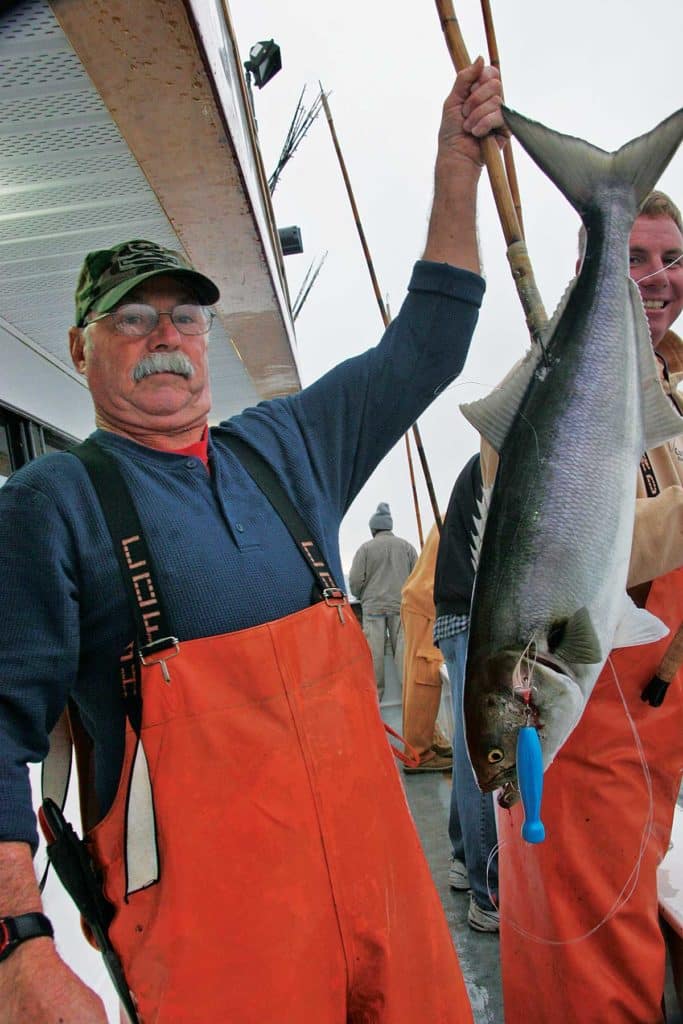
Another productive technique is to jig with S&G Tackle’s AVA A27 or A47 diamond jigs. One of the best methods is to drop the jig to the bottom, then wind it up to the surface as fast as you can, says Honachefsky.
Some of the best areas to look for big bluefish include the Sandy Hook Rip, Old Orchard Shoal (the lighthouse here was destroyed by Hurricane Sandy), West Bank Lighthouse and Swash Channel.
Tide is a negligible factor when pursuing bluefish, says Honachefsky. “You just have to be there whenever they move through chasing bait,” he observes. “If you get one, you’ll get 20.”
Honachefsky likes to use medium to heavy conventional tackle for trophy blues. “You need a 7-foot rod with enough backbone to control a gorilla bluefish,” he advises. He matches the rod with a reel such as a Shimano Torium 20 spooled with 20- to 30-pound-test monofilament. A short wire leader helps prevent bluefish from biting off a lure.
With fish so close to home, you can jump on them quickly, even after work on a long summer day. I can’t think of a better way to spend a midweek evening than pursuing these hard-fighting backyard trophies.

